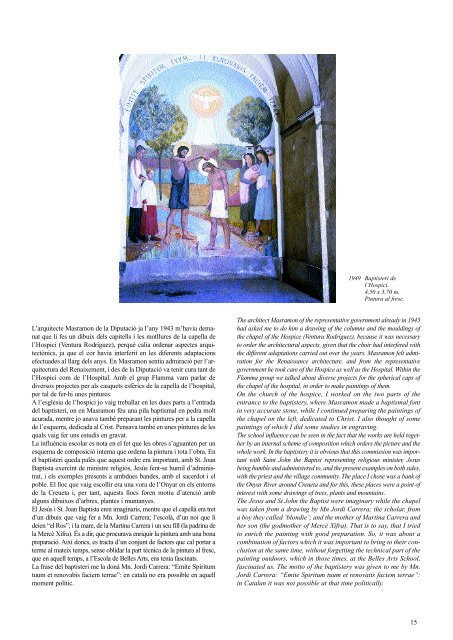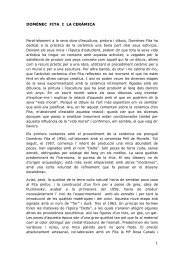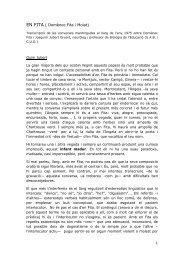- Page 3 and 4: FUNDACIÓ FITA PRESIDENT Domènec F
- Page 5 and 6: 4 estudi de la carrera. Encara hav
- Page 7 and 8: 6 veure’t obligat a precipitar-ne
- Page 9 and 10: 8 which would transform large group
- Page 11 and 12: 10 It makes one panic to find one-s
- Page 13 and 14: 12 1946 Marededéu del Carme. 66 x
- Page 15: 14 1949 Baptisteri. 35 x 25 cm. Lla
- Page 19 and 20: 1949-50 Capella Montserrat. Parròq
- Page 21 and 22: 20 És una placa en record del Bisb
- Page 23 and 24: 22 Pica baptismal. Baptisteri Belé
- Page 25 and 26: 24 A la clínica vaig fer algunes o
- Page 27 and 28: 26 El grup Flamma va participar en
- Page 29 and 30: 28 Cal tenir present que els amics
- Page 31 and 32: 30 A la mateixa clínica de St. Jos
- Page 33 and 34: 32 En un primer moment vaig pensar
- Page 35 and 36: 34 Crist jacent detall.
- Page 37 and 38: 36 En aquell temps també pensava e
- Page 39 and 40: 38 Sobre una superfície de més de
- Page 41 and 42: 40 L’encàrrec d’aquest monumen
- Page 43 and 44: 42 El procés de realització d’a
- Page 45 and 46: 44 1960 Club Natació Banyoles. Esg
- Page 47 and 48: 46 Recordo que la comissió d’art
- Page 49 and 50: 48 Hi vaig realitzar diversos treba
- Page 51 and 52: 50 1961 Seat Girona. Porta 200 x 10
- Page 53 and 54: 52 1961 Sant Andreu. 2,23 cm. Ferro
- Page 55 and 56: 54 En recordar aquest Sant Benet qu
- Page 57 and 58: 56 L’Abat tenia la idea d’un Sa
- Page 59 and 60: 58 Si bé jo ja havia treballat amb
- Page 61 and 62: 60 M’encarregaren un Sagrat Cor p
- Page 63 and 64: 62 Maquetes i peces definitives. A
- Page 65 and 66: 64 1963 Crist. Carmelites Terrassa.
- Page 67 and 68:
66 Aquestes peces foren concebudes
- Page 69 and 70:
68 Si bé el valor espiritual rau e
- Page 71 and 72:
70 1964 Clínica Salus Infirmorum.
- Page 73 and 74:
72 El símbol de l’IESE de Barcel
- Page 75 and 76:
74 Vaig pensar aquesta obra per a l
- Page 77 and 78:
76 El linòleum és el fil conducto
- Page 79 and 80:
78 Tant la mida com el material, l
- Page 81 and 82:
80 Quan tens un encàrrec, primer t
- Page 83 and 84:
82 Aquesta casa oferia maquinària
- Page 85 and 86:
84 En resultar massa fosca l’entr
- Page 87 and 88:
86 El més gran fa 4 x 16 m de llar
- Page 89 and 90:
88 És una estructura de ferro, con
- Page 91 and 92:
90 1966 Maqueta. Marededéu Parròq
- Page 93 and 94:
92 És important que veiem que un d
- Page 95 and 96:
94 Aquests vitralls estan inspirats
- Page 97 and 98:
96 1966 Vitrall Parròquia Sant Pau
- Page 99 and 100:
98 El vitrall central fou concebut
- Page 101 and 102:
100 Sempre és enriquidor el contac
- Page 103 and 104:
102 1967 Monument al P. Menni. Asil
- Page 105 and 106:
104 Aquesta senzillesa i simplifica
- Page 107 and 108:
106 Calia crear un conjunt escultò
- Page 109 and 110:
108 La Televisió de Catalunya, per
- Page 111 and 112:
110 1968 Banc Atlàntic Barcelona.
- Page 113 and 114:
112 1968 Dansa Casa Campos. 112 cm.
- Page 115 and 116:
114 Les etapes històriques de la i
- Page 117 and 118:
116 Vaig encarregar-me de l’entra
- Page 119 and 120:
118 L’autopista passava per sobre
- Page 121 and 122:
120 1969 Mur d’entrada. Casa Fita
- Page 123 and 124:
122 1969 Casa Fita-Rodeja.
- Page 125 and 126:
124 1969 Casa Fita-Rodeja. Gravat s
- Page 127 and 128:
126 1969 Casa Fita-Rodeja. Llindes
- Page 129 and 130:
128 1970 Casa Fita-Rodeja. 190 x 74
- Page 131 and 132:
130 1969 Banc Atlàntic Girona. 11
- Page 133 and 134:
132 Aquesta obra és fruit d’un c
- Page 135 and 136:
134 Aquesta obra té el seu origen
- Page 137 and 138:
136 Aquesta idea de servir et porta
- Page 139 and 140:
138 1970 Sant Antoni de Calonge. 33
- Page 141 and 142:
140 1970 Sant Antoni de Calonge. 33
- Page 143 and 144:
142 Les papallones van ser fetes ta
- Page 145 and 146:
144 1970 Caixa de Girona. Sant Feli
- Page 147 and 148:
146 Es tractava d’un plafó amb r
- Page 149 and 150:
148 1970 Caixa Pensions Girona. Fra
- Page 151 and 152:
150 Són dos murals de rajoles esma
- Page 153 and 154:
152 El ciment armat que hi ha a l
- Page 155 and 156:
154 Entre moltes d’altres, l’am
- Page 157 and 158:
156 Una franja de 60 cm d’alçada
- Page 159 and 160:
158 1970 Caixa de Pensions, Palafru
- Page 161 and 162:
160 Aquí mostro dos vitralls (fine
- Page 163 and 164:
162 1971 Crist Santa Joaquima Vedru
- Page 165 and 166:
164 Es tracta d’un basament en ci
- Page 167 and 168:
166 L’arquitecte Miquel Batet vol
- Page 169 and 170:
168 En aquest establiment es tracta
- Page 171 and 172:
170 Es tracta d’una façana de ca
- Page 173 and 174:
172 1972 Banc de Girona. Palafrugel
- Page 175 and 176:
174 Un mur cobert entorn de la pisc
- Page 177 and 178:
176 És un mur de dos costats, i la
- Page 179 and 180:
178 És un relleu de 15 m de llarg,
- Page 181 and 182:
180
- Page 183 and 184:
182
- Page 185 and 186:
184 Una superfície texturada i gra
- Page 187 and 188:
186 1973 Parròquia Sant Feliu de G
- Page 189 and 190:
188 El client, en aquest cas, era l
- Page 191 and 192:
190 1973 Via crucis. Abadia de Mont
- Page 193 and 194:
192 1974 Via crucis. Abadia de Mont
- Page 195 and 196:
194 1974 Via crucis. Abadia de Mont
- Page 197 and 198:
196
- Page 199 and 200:
198
- Page 201 and 202:
200 Tres finestrals llargs que done
- Page 203 and 204:
202 En un vitrall, tant si és empl
- Page 205 and 206:
204 És un privilegi poder honorar
- Page 207 and 208:
206 Aquesta vegada fou l’arquitec
- Page 209 and 210:
208 En voler convertir un restauran
- Page 211 and 212:
210 1976 Parròquia Sallent. 300 x
- Page 213 and 214:
212 Aquesta gelosia, tancada pel ca
- Page 215 and 216:
214 Es tracta d’un mur corbat pel
- Page 217 and 218:
216 Volíem fer un balcó, la forma
- Page 219 and 220:
218 1976 Obelisc. Mirador d’Empú
- Page 221 and 222:
220 Encara que sempre feia obres pe
- Page 223 and 224:
222 El tema i l’espai tenen unes
- Page 225 and 226:
224 Tant el lloc com la tasca són
- Page 227 and 228:
226 1977 Font casa Mateu Cassà de
- Page 229 and 230:
228 Entre els primers contactes i e
- Page 231 and 232:
230 Cada obra compleix unes funcion
- Page 233 and 234:
232 1978 Font de Motjuïc Girona. 6
- Page 235 and 236:
234 1978 Casa Vich Girona. 129 x 11
- Page 237 and 238:
236 1978 Casa Roser Cassà de la Se
- Page 239 and 240:
238 Sant Antoni de Calonge. 250 x 6
- Page 241 and 242:
240 Sant Antoni de Calonge. 250 x 6
- Page 243 and 244:
242 1978 Parròquia Sant Antoni de
- Page 245 and 246:
244 1978 Casa Xena Barcelona. 185 x
- Page 247 and 248:
246 1978 Casa Rigat Olot. Fragment.
- Page 249 and 250:
248 1979 Casa Peris Girona. 67 cm a
- Page 251 and 252:
250 La meva tasca per a l’art en
- Page 253 and 254:
252 Es tractava de tancar un espai
- Page 255 and 256:
254 1980 Casa Illa Arenys de Munt.
- Page 257 and 258:
256 1981 Centre Comercial Montjuïc
- Page 259 and 260:
258 1981 Centre Comercial Montjuïc
- Page 261 and 262:
260 1981 Centre Comercial Montjuïc
- Page 263 and 264:
262 1981 Residència Maria Gay Giro
- Page 265 and 266:
264 1981 Casa Gairin, Girona. 180 x
- Page 267 and 268:
266 1981 Casa Gairin Girona. 180 x
- Page 269 and 270:
268 1980-81 Caixa de Pensions Giron
- Page 271 and 272:
270 1981 Caixa Pensions Girona.
- Page 273 and 274:
272 La matèria escollida per reali
- Page 275 and 276:
274 A la columna de l’atri exteri
- Page 277 and 278:
276 1982 Cor de Maria, Girona. Bapt
- Page 279 and 280:
278 1982 Cor de Maria, Girona. Sím
- Page 281 and 282:
280 1982 Cor de Maria, Girona. Euca
- Page 283 and 284:
282 1982 Cor de Maria, Girona. Amb
- Page 285 and 286:
284 Un lloc tan especial, on es red
- Page 287 and 288:
286 En la tasca empresa en aquesta
- Page 289 and 290:
288 1983-84 Parròquia Campredó (T
- Page 291 and 292:
290 1983-84 Parròquia Campredó. H
- Page 293 and 294:
292 1983-84 Parròquia Campredó. H
- Page 295 and 296:
294 1983 Parròquia Campredó. Frag
- Page 297 and 298:
296 1983 Parròquia Campredó. Frag
- Page 299 and 300:
298 Es tracta d’un espai de bosc
- Page 301 and 302:
300 1984 Centre Joan Riu. 17 cm alt
- Page 303 and 304:
302 1984 Centre Joan Riu.
- Page 305 and 306:
304 1984 Símbol al treball. 40 cm.
- Page 307 and 308:
306 La situació de la peça és al
- Page 309 and 310:
308 1985 Estudi marqueteri Mercuri.
- Page 311 and 312:
310 1985 Rosassa parròquia d’Ame
- Page 313 and 314:
312 1986 Estudi monument al general
- Page 315 and 316:
314 1987 Mans. Punts de referència
- Page 317 and 318:
316 1987 Mans. Punts d’atenció.
- Page 319 and 320:
318 Fer escultures en pedra i jugar
- Page 321 and 322:
320 1987 Llar infantil. Capella de
- Page 323 and 324:
322 Projecte de deu vitralls emplom
- Page 325 and 326:
324 1998 Parròquia Vista Alegre. G
- Page 327 and 328:
326 1998 Parròquia Vista Alegre. G
- Page 329 and 330:
328 Es tracta d’una peça de 12,5
- Page 331 and 332:
330 1988 Mil·lenari Sant Hilari Sa
- Page 333 and 334:
332 1989 Casa Lluís Roig, Ullà (G
- Page 335 and 336:
334 1989 Casa Lluís Roig, Ullà Vi
- Page 337 and 338:
336 1989 Casa Lluís Roig, Ullà. 1
- Page 339 and 340:
338 1989 Casa Lluís Roig, Ullà. 1
- Page 341 and 342:
340 1989 Mirall. Casa Roig Ullà. 1
- Page 343 and 344:
342 1989 Vitrix. Olot. 68 cm alçad
- Page 345 and 346:
344 1989 Monument al Pescador de Ro
- Page 347 and 348:
346 1990 Monument al Pescador de Ro
- Page 349 and 350:
348 L’Ajuntament de Sant Hilari S
- Page 351 and 352:
350 1991 Estudi Cap del General Mor
- Page 353 and 354:
352 1991 Estudi Cap del General Mor
- Page 355 and 356:
354 1991 Monument al General Moragu
- Page 357 and 358:
356 1991 Orfeó català. Barcelona.
- Page 359 and 360:
358 1991 Orfeó català. 44 cm alt.
- Page 361 and 362:
360 Els claretians em van demanar u
- Page 363 and 364:
362 1991 Pare Claret. Museu de Vic.
- Page 365 and 366:
364 Es tractava d’una plaça on s
- Page 367 and 368:
366 1991 Ordino. Andorra. Plaça Mn
- Page 369 and 370:
368 En una obra que s’ha d’inte
- Page 371 and 372:
370 1993 Parròquia Sant Josep. Rip
- Page 373 and 374:
372 La construcció d’una esglés
- Page 375 and 376:
374 Amb motiu de preparar una impor
- Page 377 and 378:
376 1994 Porta dels Apòstols. Cate
- Page 379 and 380:
378 1994 Porta dels Apòstols. Timp
- Page 381 and 382:
380 1994 Apòstols. 18 cm alt. Guix
- Page 383 and 384:
382 1994 Apòstols. 18 cm alt. Guix
- Page 385 and 386:
384 1994 Apòstols. 18 cm alt. Guix
- Page 387 and 388:
386 1994 Apòstols. 18 cm alt. Guix
- Page 389 and 390:
388 1995 Monument a Pere Calders. L
- Page 391 and 392:
390 1995 Monument a Pere Calders. L
- Page 393 and 394:
392 Aquí hi podríem sumar les alt
- Page 395 and 396:
394 1997 Pare Claret. Catedral de V
- Page 397 and 398:
396 1997 Medalla per l’Àngela. 6
- Page 399 and 400:
398 1997 Capella Carmelites. Caldes
- Page 401 and 402:
400 1999 Sant Benet. Sant Feliu de
- Page 403 and 404:
402 1999 Claretians de Vic. 184 x 9
- Page 405 and 406:
404 1999 Moble Casa Fita Rodeja. 19
- Page 407 and 408:
406 2000 Casa Fita Rodeja. Tanca 1,
- Page 409 and 410:
408 2000 Barana Hotel Soldeu Andorr
- Page 411 and 412:
410 2000 Projecte Temple porta per
- Page 413 and 414:
412 Amb en Joaquim Rabaseda vam pre
- Page 415 and 416:
414 2002 Oliba bisbe de Vic. Maquet
- Page 417 and 418:
416 2004-2005 Sport Soldeu Andorra.
- Page 419 and 420:
418








